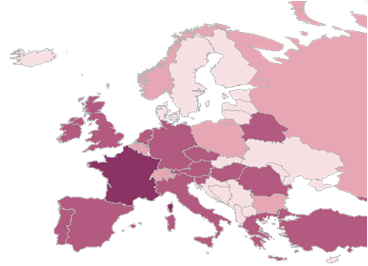The Census Project

Population censuses have been an invaluable resource for social science research for a long time. The main limitation was the necessity to rely on the only tables the statistical offices decided to produce. There were also drastic restrictions in the possibility to compare census results through time and space, across borders, because of changes or diversity in the classifications that organize the processing of the original data.
These major obstacles are largely overcome by the possibility offered to any researcher to access the individual records that will let her/him organize the production of any new tabulation. It is the objective of the Integrated European Census Microdata base, one of the world’s largest integrated research infrastructure for the study of human populations, now under construction. Detailed information in the records and metadata also lower the obstacles to comparisons through time and space, the more so efficiently as a historical and comparative database also takes on board harmonized data provided by teams in charge with the preparation of the integrated material. An opportunity is so offered to move from mere precise description of social structures to a more refined testing of assumptions in theory-driven research, through the observation of millions of individuals.
Thanks to official statistical agencies in 18 European countries, the database will contain anonymized microdata samples encompassing as many as 50 censuses and totaling more than 70 million person records. Integration and full documentation of the data are being organized by the Minnesota Population Center. The Centre d’Estudis Demogràfics has EU FP6 Support for enhancing, harmonizing and disseminating the integrated European microdata and metadata as well as for coordinating tasks based in Europe.
The first data release was completed by autumn 2006 for five countries, 13 censuses (Belarus, 1999; France, 1962, 1975, 1982, 1990; Greece, 1981, 1991, 2001; Romania, 1992, 2002; Spain, 1981, 1991, 2001). In June 2007, Hungary and Portugal were added to the database. The present proposal focus on these first 7 countries, covering some 22 censuses.
The proposal is to evaluate through demographic methods the coverage and quality of the database. It result in guidelines for good practices for potential users of the database. The evaluation and the training of users is provided by three teams of French researchers, the International Comparisons Unit of INED, the European Demographic Observatory and the Institute for Demographic Studies at Bordeaux University. They have the agreement of the American and Spanish centers who build the database, but they are fully independent from them.
The harmonization project IPUMS:
IPUMS-International is a project to collect, harmonize and disseminate census microdata samples of anonymized all countries of the world, so they are usable by researchers.The objective is to enable the IPUMS to make comparisons between countries (which does not exist elsewhere) from micro data, through harmonized variables "integrated"(which allows comparison between countries), while by providing explicit information on metadata and documentation of the full census. Moreover, IPUMS also makes available to researchers the non-standard data (raw variables available).
The census microdata available IPUMS concern all continents, with the provision of samples of microdata place census of more than fifty countries, dating from country to country, up to a fifty years.
More particularly, in the IPUMS data for Europe correspond to the project MISC: Integrated European Census Microdata.
INTEGRATED EUROPEAN CENSUS MICRODATA (IECM):
Thanks to the support of official statistical agencies from a large number of European countries, the Integrated European Census Microdata (IECM) database, one of the world’s largest integrated research infrastructure for the study of human populations, is now under construction.
The database will contain anonymized microdata samples encompassing as many as 50 censuses and totaling more than 70 million person records. With major funding by the National Institutes of Health (NIH) of the United States, integration and full documentation of the data are being organized by the Minnesota Population Center, in parallel with similar activities covering other parts of the world with sustained funding by the National Science Foundation of the United States.
By 2010, the IPUMS International is committed to disseminating at least 150 integrated census microdata sets from 40 or more countries. European censuses will constitute approximately one-third of the database thanks to the widespread support of national statistical agencies in Europe.
The Centre d’Estudis Demogràfics (CED) has been successful in attracting European Union Sixth Framework Programme support for enhancing, harmonizing and disseminating the integrated European microdata and metadata as well as for coordinating tasks based in Europe.
IECM projects are :
- Harmonazing the integrated European Census Microdata
- Disseminating the Integrated European Census Microdata
- Coordinating the integrated European Census Microdata
- IPUMS Europe: Integrating the Region’s Microdata
